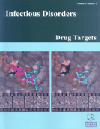- Home
- A-Z Publications
- Infectious Disorders - Drug Targets (Formerly Current Drug Targets - Infectious Disorders)
- Previous Issues
- Volume 11, Issue 1, 2011
Infectious Disorders - Drug Targets (Formerly Current Drug Targets - Infectious Disorders) - Volume 11, Issue 1, 2011
Volume 11, Issue 1, 2011
-
-
Editorial [Hot topic: Infectious Diseases and Hematology: At the Crossroad of Contemporary Therapy (Guest Editors: Hau C. Kwaan and Michael G. Ison)]
More LessAuthors: Hau C. Kwaan and Michael G. IsonThe fields of infectious diseases and hematology frequently intersect. Many hematologic disorders, particularly the hematologic malignancies, predispose the patient to a wide range of infectious complications. Conversely, infections have an effect on the hematologic picture, either directly, such as anemia of chronic infection, or leukocytosis associated with most bacterial infections, or indirectly, such as sepsis complicated b Read More
-
-
-
Epidemiology and Management of Infectious Complications in Contemporary Management of Chronic Leukemias
More LessThis is a review of the epidemiology and management of infectious complications in contemporary management of chronic leukemias. Patients with chronic leukemias typically are affected by nuisance infections due to the underlying hematologic condition, particularly hypogammaglobulinemia in CLL patients. With active treatment, particularly those agents that cause defects in cell-mediated immunity, the incidence of opportunist Read More
-
-
-
Epidemiology and Prevention of Bacterial Infections in Patients with Hematologic Malignancies
More LessAuthors: Jeffrey Tessier and Costi D. SifriBacterial infections are a serious complication of hematologic malignancies and the therapies used to treat them. Neutropenia can result from the malignancy itself or develop as a complication of chemotherapy and remains a major risk factor for the development of infections in these patients. In addition, the mechanical and chemotherapeutic interventions applied to patients with hematologic malignancies impose add Read More
-
-
-
Challenges and Advances in Infection Control of Hematopoietic Stem Cell Transplant Recipients
More LessAuthors: Claire E. Magauran and Cassandra D. SalgadoHematopoietic Stem Cell Transplantation (HSCT) has revolutionized the outcome of many malignant and nonmalignant disorders; however, infection still accounts for a substantial number of deaths after both allogeneic and autologous transplants. Hospital-acquired infections (HAI) such as bloodstream infections, pneumonias, and diarrhea are common in this population and account for significant morbidity and cost of ca Read More
-
-
-
Epidemiology and Prevention of Viral Infections in Patients with Hematologic Malignancies
More LessViral infections are some of the most frequent complications in patients with hematologic malignancies are viral infections. Infections caused by cytomegalovirus, herpes simplex virus, varicella zoster virus, hepatitis B virus and influenza virus are associated with high morbidity and mortality in this vulnerable population. Fortunately, a growing number of antiviral medications and vaccines are allowing for more effective prophyla Read More
-
-
-
Epidemiology, Prevention, and Management of Influenza in Patients with Hematologic Malignancy
More LessInfluenza results in annual epidemics of respiratory viral illness during the winter; when a novel virus enters the human population, a pandemic may result with a larger proportion of the population sickened. Unlike the mild and typically self-limited disease seen in immunocompetent patients, immunocompromised patients frequently have a more severe course. These individuals shed virus for a prolonged period of time, have Read More
-
-
-
Infection and Anemia
More LessBy Hau C. KwaanAnemia most frequently accompanies infection in varying degrees and in different forms. Anemia of inflammation is the most common and is due to over-expression of hepcidin. This is followed by hemolytic anemia, red cell aplasia and blood loss. The degree of anemia may not necessarily be proportional to the severity of the infection, nor is it specific for the type of infection. A clear understanding of these diverse causes and Read More
-
-
-
Approaches to Minimize Infection Risk in Blood Banking and Transfusion Practice
More LessAuthors: Paul F. Lindholm, Kyle Annen and Glenn RamseyThe use of blood donor history and state-of-the-art FDA-licensed serological and nucleic acid testing (NAT) assays have greatly reduced the “infectious window” for several transfusion-transmitted pathogens. Currently transmission of human immunodeficiency virus (HIV), Human T-cell Lymphotropic Virus (HTLV), hepatitis viruses and West Nile Virus are rare events. The seroprevalence of cytomegalovirus in the donor po Read More
-
-
-
HIV-1 Infected Patients have Antibodies Recognizing Folded Tat
More LessAuthors: Sonia Mediouni, Gilbert Baillat, Albert Darque, Isabelle Ravaux and Erwann LoretTat is a regulatory viral protein known as transactivator of HIV-1 genes but Tat is also secreted in the blood from HIV-1 infected cells. Extra cellular Tat can cross cellular membranes to trigger apoptosis and might explain the incapacity of the cellular immunity to eliminate HIV-1 infected cells. There is a controversy regarding Tat structure with studies suggesting that Tat would be a naturally unfolded protein. Here, we show that Read More
-
-
-
Development of Anti-Viral Agents Using Molecular Modeling and Virtual Screening Techniques
More LessComputational chemistry has always played a key role in anti-viral drug development. The challenges and the quickly rising public interest when a virus is becoming a threat has significantly influenced computational drug discovery. The most obvious example is anti-AIDS research, where HIV protease and reverse transcriptase have triggered enormous efforts in developing and improving computational methods. Methods appl Read More
-
Volumes & issues
-
Volume 25 (2025)
-
Volume 24 (2024)
-
Volume 23 (2023)
-
Volume 22 (2022)
-
Volume 21 (2021)
-
Volume 20 (2020)
-
Volume 19 (2019)
-
Volume 18 (2018)
-
Volume 17 (2017)
-
Volume 16 (2016)
-
Volume 15 (2015)
-
Volume 14 (2014)
-
Volume 13 (2013)
-
Volume 12 (2012)
-
Volume 11 (2011)
-
Volume 10 (2010)
-
Volume 9 (2009)
-
Volume 8 (2008)
-
Volume 7 (2007)
-
Volume 6 (2006)
Most Read This Month
Article
content/journals/iddt
Journal
10
5
false
en


